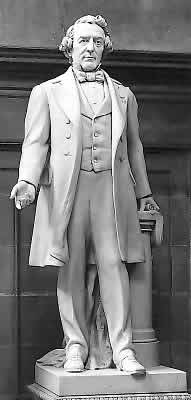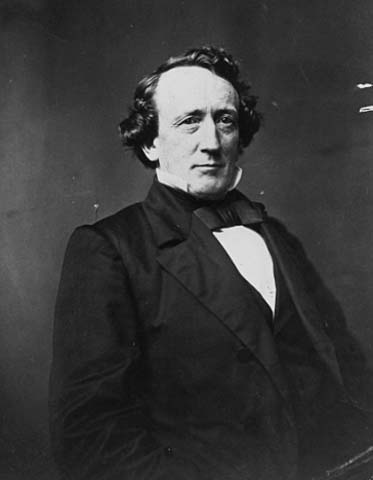Name behind the county—Henry Mower Rice
The hall is impressive: two-stories high with a cast-steel ceiling, semicircular, and everywhere you look is a marble column lining the perimeter. This chamber is known as the National Statuary Hall in the United States Capitol and this is where you will find two of your own. In 1864 Congress authorized the President to invite each state to bestow this honor, casting their likeness in bronze or marble, upon two worthy deceased citizens for their “…historic renown or for distinguished civic or military service.” (www.aoc.gov/art) In 1916 the state of Minnesota chose their first citizen to honor—Henry Mower Rice.
He had lived and worked hard in a time of pioneer expansion accomplishing great things for his state, its people, and its future, driven by his love for the land and his vision for what they could become. This is what moved his fellow Minnesotans to place his likeness among other worthy Americans in our nation’s capital. However, more than 60 years earlier, he was accorded an honor that has put his name before fellow Minnesotans on a daily basis in every generation since—an honor based on friendship and loyalty. He is the man behind Rice County.

Henry Mower Rice was born in Vermont in 1816, the oldest of ten children. Losing his father in childhood, he was raised by friends. He was able to pursue an education, studying law, and, like many before him, found his way west. In Michigan, he worked as an assistant engineer on important public works projects and took jobs as a sutler which eventually led him to work with the trade company of Pierre Chouteau. This appealed to his spirit of adventure taking him to distant places throughout the Michigan Territory trading with the Winnebago and Chippewa tribes. He became known and trusted by the Chippewa, brokering many treaties which earned him the nickname “White Rice” for his honesty of character.
His travels took him to Minnesota and, upon seeing the beauty of what would become St. Paul, knew he had found his home. He wrote to a friend, “…I hope to return to the St. Peter’s and make that my future home. I believe that region to be destined to become a center of a great state.” (Minnesota in Three Centuries) With that in mind, he helped negotiate treaties with the area Indian tribes which were instrumental in opening Indian Territory to white settlement. He used his business skills to invest in Minnesota real estate and he worked in the territorial government to make statehood for Minnesota a reality, also serving as one of its first U.S. Senators.
Statues of men like Henry Mower Rice remind us that they were more than a name, that they were once flesh and blood. They faced life’s hardships as well as blessings and the choices they made did make a difference for generations to come. His name on a Minnesotan county reminds us of his love for the land and the people who lived there during his lifetime, Indian and white, and the people who would come to work the land and make it great. The opportunities for a good life are within the reach of all people. Read more here.
CREDIT: commons.wikimedia.org

